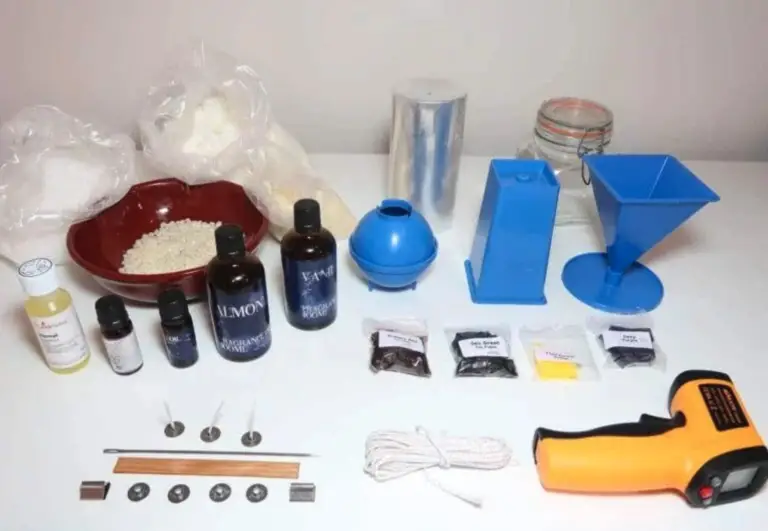How Do I Start My Own Candle-Making Business?
Deciding on Your Candle Business
The first step in starting a candle making business is deciding what types of candles you want to make. There are many options to consider:
Types of Candles
Some of the most popular candle styles are container candles, pillars, tapers, votives, tealights, and novelty candles. Container candles are poured into jars or other holders, while pillars, tapers, votives, and tealights are freestanding. Novelty candles come in unique shapes and sizes.
Scented vs Unscented
Another key decision is whether to make scented or unscented candles. Most consumers buy scented candles, so offering a variety of pleasing fragrances can attract customers. However, there is still a market for high-quality unscented beeswax or soy candles.
Poured vs Molded
You’ll also need to choose between poured and molded manufacturing methods. Poured candles involve melting wax and pouring it into containers and molds. This allows for layering of colors and scents. Molded candles use pre-formed wax sheets and wicks.
Types of Wax
Paraffin, soy, beeswax, and palm wax are some of the most common waxes for candle making. Paraffin is affordable and easy to use but is a petroleum product. Soy and beeswax are natural options. Each wax has different properties that affect burn time, melting point, scent throw, and more [1].
Researching the Market
Before starting your candle making business, it’s important to research the market and understand your competition. The global candle market is expected to reach $13.2 billion by 2023, with a CAGR of 3.7% from 2017-2023 (https://www.linkedin.com/pulse/candle-market-size-2023-growth-status). Key factors driving this growth are increasing demand for natural, eco-friendly candles and innovative scented candle variants. The scented candle market alone is projected to reach $3.7 billion by 2025, growing at a CAGR of 5.9% (https://www.linkedin.com/pulse/scented-candle-market-size-latest-trends-z4exc/).
When researching competitors, look at both large manufacturers and local candle makers. Evaluate their pricing, product lines, marketing, and brand image. This will help you identify an ideal target customer and price point. For example, you may decide to focus on premium natural soy candles, competing with brands like Yankee Candle. Or you may aim for budget conscious shoppers, undercutting competitors’ prices.
It’s also important to understand your local target customer base. Visit craft fairs, home decor shops, and other locations where you may sell your candles. Talk to potential customers to gain insight into popular scents, sizes, container styles and pricing. This market research will help you create products and set prices to effectively compete in your region.
Business Planning

Creating a thorough business plan is a crucial step when starting any new business. This will help you define your business concept, set goals, outline operations and finances, and create a roadmap for achieving success. Your business plan should cover key areas like:
- Executive summary outlining your business and objectives
- Description of your products or services
- Market analysis of customers and competitors
- Marketing strategy for attracting customers
- Operational plan for managing your business
- Financial projections including startup costs, sales forecasts, and profit/loss
For a candle business, your business plan should provide details on your candle products, target customers, pricing, promotional tactics, and expected sales and costs. Use conservative estimates for projected revenue and expenses, as it often takes time to build sales. Outline your plan for managing operations like production, inventory, quality control, and order fulfillment. Your marketing strategy could include tactics like social media, online ads, craft fairs, and partnerships with local shops. Keep your business plan updated as your business grows and evolves.
Having a thoughtful business plan allows you to secure funding, manage operations efficiently, and track progress against your goals. Take time to research and create a realistic plan to set your candle business up for success.
Sources:
https://www.bankofamerica.com/smallbusiness/resources/post/how-to-write-effective-small-business-plan/
Naming Your Business
Choosing the right name for your candle business is an important first step. The name should be memorable, easy to say and spell, and communicate something about your brand. Here are some tips for brainstorming and selecting the perfect name:
Brainstorm a list of possible names. Consider different types of names like descriptive names that say what your business does (e.g. Mary’s Candle Co.), evocative names that evoke a feeling (e.g. Flicker), or abstract names (e.g. Wick & Fire). You can use name generators like Next Insurance and FindLaw for inspiration.
Check domain name availability. Once you have a shortlist, see if the domain name is available for your website and register it.
Do a trademark search. Use the USPTO’s free search tool to see if your name is already trademarked. Getting a trademark can prevent others from using your business name.
Get objective feedback. Ask a focus group for their impressions of your top contenders to help select the winning name.
Aim for a name that is memorable, easy to say and spell, aligns with your brand identity, and is legally available as your business name and domain. The right business name can help make a great first impression and build brand recognition over time.
Registering Your Business
After you have come up with a business name, one of the next steps is to legally register your business. There are a few important licenses and registrations you will need to operate legally:
- Business License – Most states and local municipalities require you to register your business name and obtain a general business license. Requirements vary but generally involve filing paperwork and paying fees.
- Sales Tax License – If you plan to sell products, you will need to register with your state revenue department to collect and remit sales tax. You will receive a sales tax ID number.
- EIN – You will need an Employer Identification Number (EIN) from the IRS even if you don’t plan to have employees. This number identifies your business for tax purposes.
The Small Business Administration provides guidance on registering your business both on the federal level and for your particular state. Having the proper licenses and registrations will legitimize your business and allow you to operate legally.
Production Planning
Production planning is essential for starting a candle business. You’ll need to select the right supplies and equipment, as well as set up a production space that allows you to safely make quality candles.
When it comes to supplies, decide on the types of wax you want to use. Common options are paraffin, soy, and beeswax. Each has their benefits and drawbacks regarding cost, scent throw, melting temperature, and more. You’ll also need candle wicks, jars/containers, fragrance oils, and dye blocks if desired. Shop around to get wholesale rates on bulk supply purchases.
Equipment needed includes wax melters, thermometers, pouring pots, and a scale to weigh out wax. You may also want molds for unique shapes, funnel pitchers, heat guns, and label printers. Look for commercial grade equipment that can handle high volume production.
Your production space should have ample work tables, storage shelves, and ventilation. Depending on your production volume, you may be able to work from a spare room in your home to start. For larger scale production you’ll likely need a separate facility with high ceilings, industrial ventilation, and fire safety equipment. Make sure to follow all local zoning and permitting regulations.
Health and Safety
Making candles can be dangerous, so it’s important to follow health and safety guidelines. According to the Occupational Safety and Health Administration (OSHA), you should take precautions against burns, respiratory issues from inhaling fumes, and slips or falls in your workspace.
OSHA recommends wearing appropriate clothing like long sleeves, pants, and closed-toe shoes for protection. Ensure your workspace has adequate ventilation to prevent buildup of flammable vapors. Keep a fire extinguisher on hand in case of accidents. Store all flammables properly in approved containers.
You’ll also need proper eye protection and masks or respirators when handling certain candle ingredients. Use extreme caution when pouring hot wax to avoid splattering and burns. Allow all materials to fully cool before handling.
Candle businesses should have adequate property and liability insurance to cover potential accidents or injuries. Review policies closely as standard homeowners policies may exclude candle making operations. You may need commercial coverage or to add riders to existing policies.
All candle products in the United States must comply with fire safety standards outlined in ASTM F2417 from the American Society for Testing Materials according to the Compliance Gate.
Record Keeping
Proper record keeping is crucial for any small business. You’ll need to keep detailed records of all your candle-making expenses, sales, inventory, and other transactions in order to track the financial health of your business, prepare taxes, and make smart decisions.
Use accounting software like QuickBooks or Xero to track income, expenses, profit/loss statements, and run reports. Keep physical or digital copies of receipts and invoices. Track inventory of candle supplies and finished products using a spreadsheet or app like Stitch Labs. Take inventory before and after events to calculate sales. Back up important records online and offsite.
For more tips, see this in-depth guide on best practices for small business record keeping.
With diligent bookkeeping habits, you’ll be able to gain financial insights into the performance of your candle business, stay compliant with taxes and regulations, and set yourself up for success.
Marketing and Sales
Building a strong marketing strategy is crucial to getting your candle business off the ground. Developing a website, being active on social media, creating appealing packaging, and choosing the right sales channels are some of the most important factors to focus on.
Having a professional website where customers can learn about your brand and shop your products online is essential in today’s digital world, according to this article. Make sure your website showcases your branding, product photos, descriptions, and has an easy checkout process.
Leveraging social media platforms like Instagram and Facebook can help spread awareness of your brand and products through beautiful imagery and engaging content, as discussed in this marketing plan overview. Run targeted ads, post often, and interact with followers.
Pay close attention to your candle labeling and packaging design. Attractive, on-brand packaging can grab customer interest and convey quality. Consider unique scents, creative names, and stylish containers.
Determine which sales channels make the most sense for your business model and target market. Options include your online shop, retail stores, boutiques, trade shows, markets, and more. Develop a multi-channel strategy to access the widest range of customers.
Growing Your Candle Business
As your candle business grows, you’ll likely need to expand your product line, hire additional staff, and scale up production. Here are some tips for sustainably growing your business:
Expand your product line strategically by identifying gaps in the market or opportunities to reach new customers. Consider adding scented candles, candle gift sets, or even non-candle products like reed diffusers or room sprays. Test new products with small batch releases before committing to mass production.
Hiring additional staff can help you scale production and fulfillment. Look for employees with candle making experience or train new hires on your production processes. Start with part-time or temporary staff to meet seasonal peaks before bringing on full-time employees. Outsource shipping and fulfillment if needed.
To scale production, you may need larger equipment and expanded workspace. Look into co-packing or renting space in a commercial kitchen to ramp up capacity. Implement lean manufacturing techniques to maximize workflow efficiency. Upgrade to industrial melting tanks and high-capacity candle making equipment.
Maintaining quality customer service and your brand identity is crucial as you grow. Invest in scalable order management and inventory systems. Focus on sustainable sourcing and ethical production practices. With careful planning, you can expand your reach while staying true to your business values.




